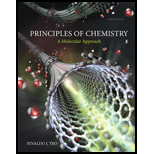
Interpretation:
The sign of
Concept introduction: The entropy of gas is more than that of liquid or solid.
To determine The sign of
Answer to Problem 17.1P
Solution:
- The change in entropy of boiling of water is positive.
- The change in entropy of the given reaction is negative.
- The change in entropy of the given reaction is positive.
(a)
Explanation of Solution
The intermolecular force of attraction of gas is less than that of liquid and solid.
Therefore, randomness of the gas is more than that of liquid or solid.
Entropy is the measurement of the randomness of a substance. Therefore, entropy of gas is more than that of liquid or solid.
The boiling of water causes the conversion of liquid water to turn into the gaseous water molecule. Therefore, the entropy of the system increases. Hence the change in entropy of boiling of water is positive.
(b)
The intermolecular force of attraction of gas is less than that of liquid and solid.
Therefore, randomness of the gas is more than that of liquid or solid.
Entropy is the measurement of the randomness of a substance. Therefore, entropy of gas is more than that of liquid or solid.
The given reaction is,
The species on the reactant side has gaseous molecule, while that on product side has solid molecules.
Therefore, the entropy of reactant is more than that of product and hence the change in entropy is negative.
(c)
The intermolecular force of attraction of gas is less than that of liquid and solid.
Therefore, randomness of the gas is more than that of liquid or solid.
Entropy is the measurement of the randomness of a substance. Therefore, entropy of gas is more than that of liquid or solid.
The given reaction is,
The species on the reactant side has one mole of solid and on the product side, there is one mole of solid and one mole of gas.
Therefore, the entropy of product is more than that of reactant and hence the change in entropy is positive.
Want to see more full solutions like this?
Chapter 17 Solutions
Principles of Chemistry: A Molecular Approach (3rd Edition)
 ChemistryChemistryISBN:9781305957404Author:Steven S. Zumdahl, Susan A. Zumdahl, Donald J. DeCostePublisher:Cengage Learning
ChemistryChemistryISBN:9781305957404Author:Steven S. Zumdahl, Susan A. Zumdahl, Donald J. DeCostePublisher:Cengage Learning ChemistryChemistryISBN:9781259911156Author:Raymond Chang Dr., Jason Overby ProfessorPublisher:McGraw-Hill Education
ChemistryChemistryISBN:9781259911156Author:Raymond Chang Dr., Jason Overby ProfessorPublisher:McGraw-Hill Education Principles of Instrumental AnalysisChemistryISBN:9781305577213Author:Douglas A. Skoog, F. James Holler, Stanley R. CrouchPublisher:Cengage Learning
Principles of Instrumental AnalysisChemistryISBN:9781305577213Author:Douglas A. Skoog, F. James Holler, Stanley R. CrouchPublisher:Cengage Learning Organic ChemistryChemistryISBN:9780078021558Author:Janice Gorzynski Smith Dr.Publisher:McGraw-Hill Education
Organic ChemistryChemistryISBN:9780078021558Author:Janice Gorzynski Smith Dr.Publisher:McGraw-Hill Education Chemistry: Principles and ReactionsChemistryISBN:9781305079373Author:William L. Masterton, Cecile N. HurleyPublisher:Cengage Learning
Chemistry: Principles and ReactionsChemistryISBN:9781305079373Author:William L. Masterton, Cecile N. HurleyPublisher:Cengage Learning Elementary Principles of Chemical Processes, Bind...ChemistryISBN:9781118431221Author:Richard M. Felder, Ronald W. Rousseau, Lisa G. BullardPublisher:WILEY
Elementary Principles of Chemical Processes, Bind...ChemistryISBN:9781118431221Author:Richard M. Felder, Ronald W. Rousseau, Lisa G. BullardPublisher:WILEY





